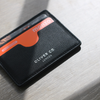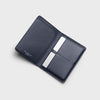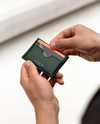We’re committed to crafting our wallets and card holders in the most sustainable way possible. Apple leather (a vegan bio-based leather) is one of the main materials we use in the Oliver Co. collection because of its premium finish, aesthetic similarities to ‘real’ leather and environmental benefits over its alternatives.
One of the most common questions we get asked is “how durable is the vegan leather?”.
We’re going to take a look at how our apple leather performs versus animal leather, digging into the advantages and challenges associated with both materials.
Vegan leather is often considered less durable than ‘real’ leather. However this is not always the case, and not all materials are made equally. A cheap leather will almost certainly degrade quicker than a high quality PU (vegan) leather.
The question comes down to quality and whether the material chosen is fit for purpose.
The durability of a material is often put down to two properties: tensile strength and abrasion resistance.












 Plain weave
Plain weave